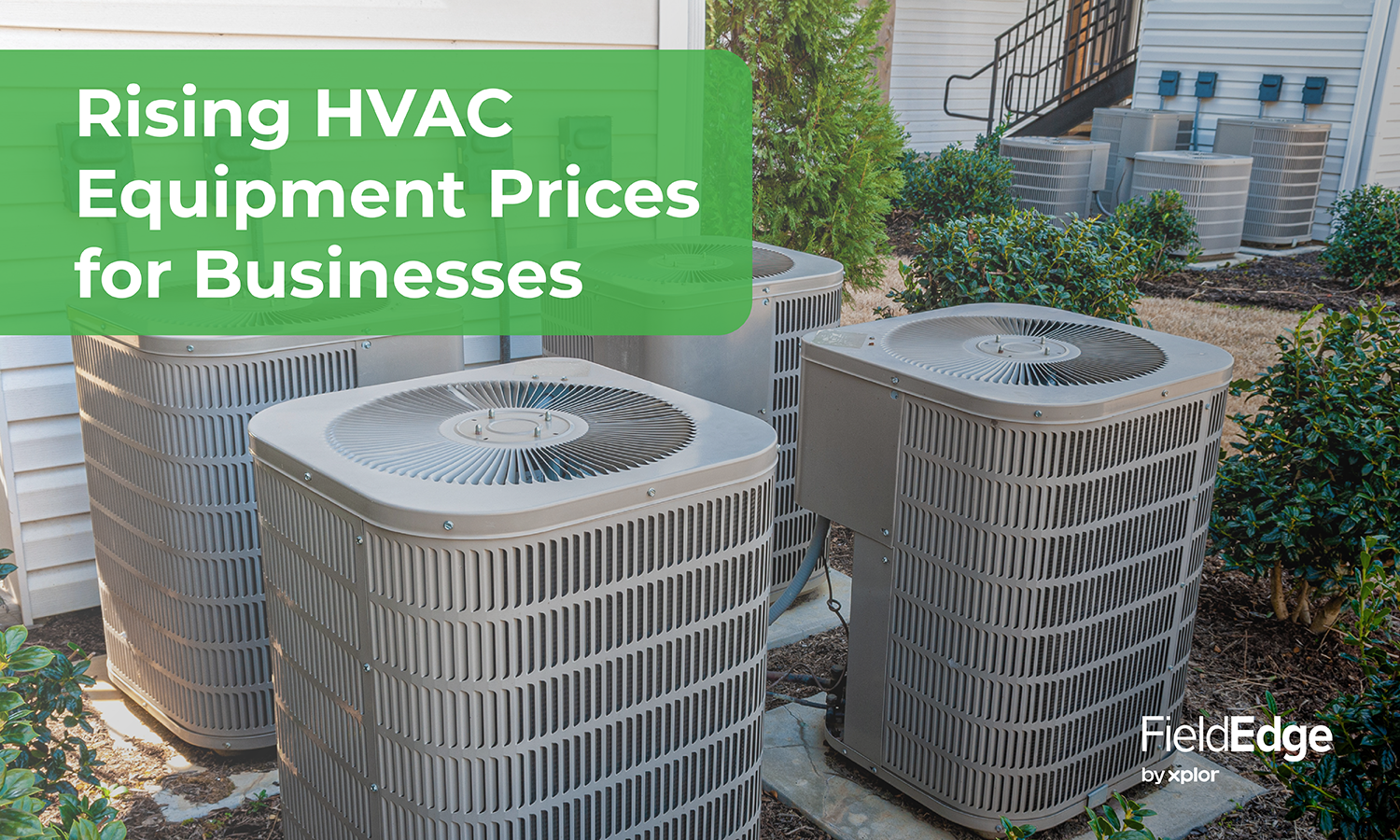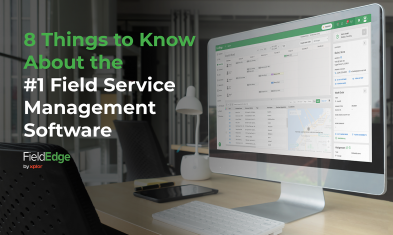As HVAC equipment prices rise for businesses, it’s essential to stay informed.
By understanding the reasons behind the increase in HVAC equipment prices, you can strategize and plan for the future—ensuring your business remains both competitive and profitable.
In this article, we will cover:
- Factors Contributing to Rising HVAC Equipment Prices
- The Impact of Supply Chain Disruptions
- Rising Material Costs
- Increased Demand and Market Dynamics
- Strategies for Managing Higher Equipment Prices
- How FieldEdge Can Help Your Business Adapt
Factors Contributing to Rising HVAC Equipment Prices
Understanding the primary factors behind rising HVAC equipment prices is crucial for planning and budgeting. At the end of 2023, several prominent HVAC manufacturers announced price increases that would continue to climb in 2024, from Carrier, Trane, Lennox and more.
These increases ranged from 5%-10% across the board, signaling an industry-wide trend. Three key elements contribute to these increases:
1. Supply Chain Disruptions
Supply chain disruptions have significantly impacted the availability and cost of HVAC equipment. These disruptions can stem from various issues, including:
- Supply chain shortages: microchips, steel, aluminum, copper, etc.
- Transportation delays: shipping, air cargo, etc.
- Labor shortages: estimated shortage of 110,000 HVAC technicians, and 25,000 techs leave their company every year
- Geopolitical tensions
2. Rising Material Costs
The cost of raw materials used in manufacturing HVAC equipment has risen steadily. Metals such as copper, aluminum and steel are essential components of HVAC systems and their price increases have a direct effect on equipment costs.
3. Increased Demand and Market Dynamics
The demand for HVAC systems has surged due to various factors, including new construction projects, the push for energy-efficient solutions and the growing need for air quality improvements. The forecasted market size is expected to exceed $250 billion by 2032, and high demand often leads to higher prices.
Now, let’s dive into each of these factors on a deeper level:
The Impact of Supply Chain Disruptions
Supply chain disruptions have been a major factor in the rising HVAC equipment prices. These disruptions affect the entire supply chain, from raw materials to finished products.
Global Transportation Challenges
Global transportation issues, such as port congestion and shipping delays, have created significant bottlenecks in the supply chain. These challenges have increased lead times and transportation costs, contributing to higher HVAC equipment prices.
Labor Shortages
Labor shortages, particularly in manufacturing and logistics, have further strained the supply chain. With fewer workers available to produce and transport goods, the cost of HVAC equipment has risen to account for these inefficiencies.
Rising Material Costs
Material costs have a direct impact on HVAC equipment prices. The price of metals, plastics and other essential materials has increased due to various economic factors.
Metal Prices
Since metals like copper, aluminum and steel are crucial for HVAC equipment, the increased cost of these metals (due to increased demand and limited supply) have driven up the cost of HVAC systems.
Let’s take a look at the pricing trends for these three metals:
Copper: Copper prices have experienced a notable rise due to tightening supply and increased demand. At the beginning of the year, copper prices ranged from $8,000-$8,500 per metric ton but saw substantial gains, reaching as high as $9,365 in April. This increase is attributed to supply bottlenecks caused by the closure of major mines and production cuts by top Chinese smelters to compete for limited supply. Additionally, the growing demand from the energy transition and AI industries has contributed to the upward trend in copper prices.
Aluminum: Aluminum prices have also been on the rise, driven by increased demand and supply constraints. The demand surge is partly due to the metal’s use in lightweight vehicles and renewable energy infrastructure. Supply issues, such as production cuts in major producing countries and increased energy costs, have further pressured prices upward.
Steel: Steel prices have seen a similar upward trajectory. Factors influencing steel prices include increased construction and manufacturing activities, higher raw material costs and supply chain disruptions. Additionally, policies aimed at reducing carbon emissions have impacted steel production, contributing to higher prices.
Plastic and Insulation Costs
Plastics and insulation materials, vital for the efficiency and durability of HVAC systems, have also seen price increases. These materials are subject to fluctuations in the oil market and supply chain constraints.
Plastic Costs:
- Rising Raw Material Costs: The cost of raw materials used in plastic production, such as ethylene and propylene, has increased significantly due to supply chain disruptions and higher crude oil prices.
Insulation Costs:
- Fiberglass Insulation: The cost of fiberglass insulation has continued to rise, driven by increased input costs and transportation surcharges. Analysts predict further incremental price increases through 2024
- Vinyl Products: Prices for vinyl insulation products have increased by 10% due to rising costs of raw materials and escalating fuel prices, affecting the overall cost structure for insulation projects.
Increased Demand and Market Dynamics
The growing demand for HVAC systems has played a significant role in rising HVAC equipment prices. Understanding the market dynamics can help businesses anticipate future trends.
New Construction and Renovations
The boom in new construction and renovation projects has led to increased demand for HVAC systems. As more buildings require heating, ventilation and air conditioning, the competition for available equipment drives prices higher.
Energy Efficiency and Environmental Regulations
The push for energy-efficient HVAC solutions and adherence to environmental regulations has increased the complexity and cost of manufacturing these systems. This trend is likely to continue as sustainability becomes a priority.
The EPA’s Technology Transitions Rule aims to decrease global warming potential (GWP) of refrigerants used in air conditioning and refrigeration gear. The ability to install R-410a systems is coming to an end on January 1, 2025. Further regulations continue through 2028.
Strategies for Managing Higher HVAC Equipment Prices
To mitigate the impact of rising HVAC equipment prices, businesses need to adopt strategies that help manage costs and maintain profitability.
Bulk Purchasing
Purchasing HVAC equipment in bulk can help secure lower prices and protect against future price increases. Building relationships with suppliers can also lead to better deals and priority access to inventory.
Investing in Technology
Investing in technology can streamline operations and reduce costs. HVAC software like FieldEdge can optimize scheduling, inventory management and customer service—making your business more efficient.
Diversifying Suppliers
Relying on a single supplier can be risky in times of price volatility. Diversifying your supplier base ensures you have multiple sources for equipment, reducing the impact of any single supplier’s price increases.
How FieldEdge Can Help Your Business Adapt
FieldEdge offers comprehensive solutions to help HVAC businesses adapt to the changing market conditions. By leveraging advanced technology, you can improve operational efficiency and customer satisfaction.
Optimizing Scheduling and Dispatch
FieldEdge’s scheduling and dispatch tools can help you make the most of your resources, reducing downtime and increasing productivity. Efficient scheduling ensures your technicians are always where they need to be, maximizing revenue.
Enhancing Customer Service
Providing excellent customer service can set your business apart in a competitive market. FieldEdge’s CRM tools help you manage customer interactions, schedule follow-ups and maintain high levels of satisfaction.
Book a FREE demo of FieldEdge today to experience how the best software will TRANSFORM your business growth!
Succeed Despite Higher HVAC Equipment Prices
The continuous rise in HVAC equipment prices presents challenges, but with the right strategies and tools, your business can navigate these changes successfully. By understanding the factors driving price increases and adopting proactive measures, you can maintain profitability and continue to grow.
Here are a few things to remember:
- Understand the Factors: Recognize the key drivers behind rising HVAC equipment prices, including supply chain disruptions, material costs and market demand.
- Adopt Strategies: Implement strategies like bulk purchasing, investing in technology and diversifying suppliers to manage higher equipment prices.
- Leverage Technology: Utilize field service management software like FieldEdge to optimize operations and enhance customer service.
- Stay Informed: Keep abreast of industry trends and market dynamics to anticipate future changes and adjust your strategies accordingly.
By staying informed and proactive, your HVAC business can thrive even in the face of rising equipment costs.
Related: New 2024 Residential Efficiency Standards: What HVAC Companies Should Know




